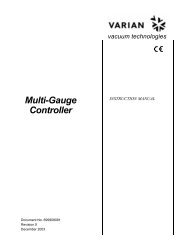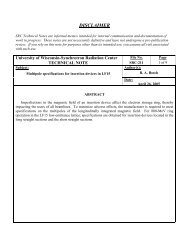SRC Users' Meeting - Synchrotron Radiation Center - University of ...
SRC Users' Meeting - Synchrotron Radiation Center - University of ...
SRC Users' Meeting - Synchrotron Radiation Center - University of ...
Create successful ePaper yourself
Turn your PDF publications into a flip-book with our unique Google optimized e-Paper software.
THE RELATIONSHIP BETWEEN PHOSPHATE SPECIATION IN SOILS<br />
AND BIOSOLIDS/MANURE MANAGEMENT PRACTICES: A P K-EDGE<br />
XANES SPECTROSCOPIC STUDY<br />
Derek Peak,Gurpal Toor, and James T Sims<br />
1 Dept. <strong>of</strong> Soil Science, 51 Campus Dr, Univ. <strong>of</strong> Saskatchewan. Saskatoon SK S7N 5A8<br />
2 Dept Plant and Soil Sciences, Univ. Delaware. 149 Townsend Hall Newark DE 19717<br />
The long-term application <strong>of</strong> animal manures and biosolids has resulted in serious<br />
environmental issues in many locations throughout the world. For example, the state <strong>of</strong><br />
Delaware has a large amount <strong>of</strong> farmland characterized as having “excessive P levels” due to<br />
heavy application <strong>of</strong> poultry waste for the last three decades. These soils serve as a significant<br />
source for phosphate movement into waters, including the Chesapeake Bay. Elevated phosphate<br />
levels in natural waters are a serious concern because it is typically the limiting nutrient for algae<br />
and other photosynthetic organisms. Increased phosphate can therefore result in algal blooms<br />
and ultimately fish kills and eutrophication.<br />
The tendency <strong>of</strong> phosphorus to move from a soil to surface waters is highly dependent<br />
upon its chemical form. In soils, phosphate has a tendency to form insoluble metal phosphate<br />
solids and to form strong sorption complexes with iron and aluminum oxides. These reactions<br />
result in phosphate typically being held very strongly by soils. In biosolids and manures,<br />
however, high levels <strong>of</strong> soluble phosphate and readily degradable organic phosphates are found<br />
along with more stable organic phosphates and calcium phosphate minerals. To attempt to<br />
reduce the environmental risk <strong>of</strong> manure applications, scientists have proposed that (a) the<br />
manures be chemically amended prior to application to reduce P availability or (b) the diet <strong>of</strong> the<br />
animals be modified to reduce P in manures. The presented research will perform direct<br />
chemical samples from a variety <strong>of</strong> animal types, diets, and chemical amendments using P K-<br />
Edge XANES spectroscopy coupled with linear combination fitting. This allows us to directly<br />
assess the success <strong>of</strong> different strategies to reduce manage phosphorus.<br />
We found that changes in animal diet do indeed play a large role in the resulting<br />
phosphate speciation. Adding supplemental P <strong>of</strong>ten served to increase the fraction <strong>of</strong> calcium<br />
phosphate minerals present. Take for example the samples in Figure 1. The DM01 sample on<br />
the left is a dairy manure sample from an animal with 29%P in its diet. The sample on the right<br />
is a dairy manure sample from an animal fed 58% P. There is a marked increase in calcium<br />
phosphate precipitation in the higher P diets, which can affect the solubility <strong>of</strong> P compared to<br />
organic and aqueous forms. XANES has similarly been useful in determining the chemistry <strong>of</strong><br />
phosphate in manures amended with aluminum coagulants.<br />
This research was supported by an NSERC Discovery grant and the Saskatchewan<br />
<strong>Synchrotron</strong> Institute.
















